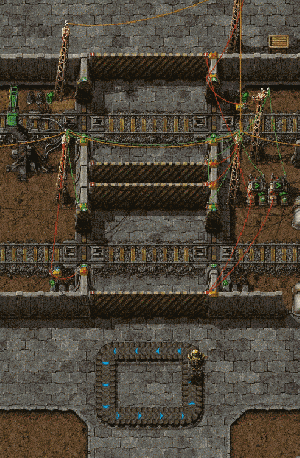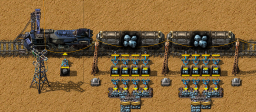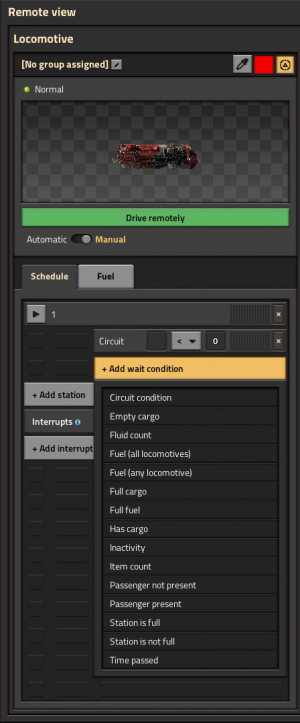User:M.C.S./wip/Railway/de
| Dieser Artikel ist ein stub und nicht umfassend. |
|---|
| Du kannst diesem Wiki helfen, indem du ihn erweiterst. |
- Für die Forschung siehe Eisenbahn (Forschung)
Die Eisenbahn ist eine der Haupttransportmethoden in Factorio. Wenngleich die Installation eines solchen Netzwerks kompliziert sein kann und große Mengen an Ressourcen und Fläche benötigt, ist es schneller und effizienter als Transportbänder und das Logistiknetzwerk, insbesondere über große Distanzen hinweg.
Der Eisenbahnbau ist zu Beginn jedoch nicht einfach zu verstehen. Das Erlernen der Grundlagen wie der Automatisierung des Transports dauert einige Zeit. Zu lernen, wie man ein größeres Eisenbahnnetzwerk verwaltet und instand hält, erfordert Zeit und Erfahrung.
Infrastruktur
Um eine Eisenbahn zu bauen, müssen Gleise (auch Schienen genannt) gebaut werden, auf denen die Züge fahren können. Dies wird üblicherweise mit dem Gleisplaner gemacht, kann aber auch manuell gemacht werden. Beachte, dass Gleise im Baugitter zwei Kacheln benötigen, weshalb ein Gleis nicht um nur eine Kachel verschoben werden kann.
Minimale manuell betriebene Eisenbahn
Eine manuell betriebene Eisenbahn besteht mindestens aus:
- Schienen (Gleise)
- Lokomotiven
Lokomotiven können betreten und dann manuell bedient werden, indem man neben ihnen steht und dann die ENTER-Taste drückt.
Weichen
- Es gibt keine visuelle Repräsentation einer funktionierenden Weiche; die Schienen scheinen zu verschmelzen. Mit dem Gleisplaner muss der Spieler eine Schiene mit einer bestehenden Schiene überlappend platzieren, um eine Weiche zu bilden. Weichen sind Abzweigungen in Gleisen, von wo aus Züge in unterschiedliche Richtungen fahren können.
- Kreuzungen zweier gerader Gleise bilden keine Weiche, da Züge einen beschränkten Wendekreis haben. Sie bilden aber einen gemeinsamen Signalblock, welcher genutzt werden kann, um Zugkollisionen zu vermeiden.
- Parallel verlaufende Gleise beeinflussen sich nicht gegenseitig. Allerdings erfordert es mehr Aufwand, von einem Gleis auf ein anderes zu wechseln, wenn der Abstand zwischen den Gleisen zu gering ist; das Gleis muss dann erst in die andere Richtung abzweigen und dann erst Richtung Zielgleis verlegt werden. Das erzeugt allerdings recht komplizierte Signalnetze, weshalb man auf den Bau parallel verlaufender Gleise verzichten sollte, sofern diese nicht ausreichend Abstand zueinander haben (üblicherweise funktioniert ein Abstand von mindestens zwei Gleisbreiten gut).

Überqueren von Gleisen
Vorsicht beim Überqueren von Gleisen! Züge sind eines der Spielobjekte mit größtmöglichen Schadenspotenzial und töten die meisten Spieler umgehend bei Kontakt mit höherer Geschwindigkeit.
Hier eine Checkliste mit bewährten Verhaltensregeln beim Überqueren von Gleisen:
- Zoome heraus, damit du einen annähernden Zug sehen kannst.
- Schau nach links, dann nach rechts.
- Beobachte Signale in der Nähe: Wenn ein Signal plötzlich von grün zu rot oder von grün zu gelb wechselt, kommt ein Zug. Warte dann mit der Überquerung.
- Vermeide nahe den Gleisen zu gehen, da du nicht vollständig auf den Gleisen sein musst, um von Zügen erfasst zu werden.
- Obwohl es möglich ist, einen Zug während dessen Fahrt zu betreten/verlassen, kann eine Ungenauigkeit das Leben kosten. The sides of the train can still deal damage, as well as the player being able to slip between two rail cars.
- Schwere Schilde können verwendet werden, um den erlittenen Schaden zu verringern. In extremen Fällen ist es möglich, einen Zug mit dem Körper anzuhalten. Dies erfordert mehrere Schildmodule, um nicht sofort getötet zu werden, und verbraucht einen großen Teil der Energie des Anzugs.
- Alle Objekte mit dem Attribut Gesundheit erleiden Schaden, wenn sie von einem Zug getroffen werden. Achten Sie daher darauf, kein Auto oder Panzer auf den Gleisen zu lassen. Achtung: Mit Gegnern kann dieser Aspekt ebenfalls eingesetzt werden!
- Züge, die weit von einem Bahnhof entfernt sind, fahren mit (nahezu) Höchstgeschwindigkeit. Sei daher beim Überqueren besonders vorsichtig und zoome weit heraus. Züge in der Nähe eines Bahnhofs oder eines roten Signals werden langsamer um anzuhalten. Züge unterschiedlicher Konfiguration und Länge bewegen sich auch langsamer oder schneller.
Wie im Bild gezeigt kann ein sicherer Bahnübergang gebaut werden. Dies funktioniert, indem der Zugang zu den Gleisen beschränkt wird, wenn für einen ankommenden Zug die Schienen reserviert sind und sich kein Spieler auf bzw. in der Nähe der Gleise befindet. Wenn sich der Spieler auf den Schienen befindet, werden die Signale vom Schaltungsnetz reserviert und der Zug muss anhalten und warten, bis der Spieler die Gleise verlässt. Wenn sich ein Spieler innerhalb des Bereichs befindet, der die Gleise überquert, werden die Zugtore geschlossen, sodass der Spieler nicht auf die Gleise außerhalb der Kreuzung gelangen kann. Dies dient der vollständig sicheren Gielsüberquerung und wird häufig auf Servern verwendet.
Züge
Zugkomponenten:
| Lokomotive | Güterwaggon | Tankwaggon | Artilleriewaggon |

- A train consists of at least one locomotive.
- Trains can have more than one locomotive, and any number of wagons.
- Locomotives can be manually driven forwards or backwards, however, they are generally slower going backwards. The left and right movement keys are used to change direction at switches.
- Trains can only drive forwards automatically. An automatic train can drive forwards and backwards when two locomotives facing different directions are connected to the train.
- A train needs fuel to drive. Fuel can be added by inserters when the train is in manual mode or parked at a station, not when waiting at a signal or standing on automatic mode.
The locomotives' inventory is only used for fuel. To transport items or fluids cargo wagons and/or fluid wagons have to be attached to the train. To attach rolling stock, whether a wagon or a locomotive, the player may either prepare to place one near an existing train, where a green graphic will show the player that the stock will be attached, showing a connection between the train and the new stock. Alternatively, the player may manually connect rolling stock to trains with the rolling stock connect key, if the cargo wagon was placed far away from a train. Rolling stock can likewise be disconnected with the rolling stock disconnect key.
Stations

Train stations are the only place where trains can be loaded or unloaded when they are in automatic mode. Cargo wagons can be filled or emptied by up to twelve adjacent inserters (six on each side). Inserters can also be used to insert fuel into locomotives. Pumps are used to transfer fluid into and out of fluid wagons, only three pumps can attach to one fluid wagon at once.
Train stations are usually created by placing a train stop. Train stops must be on the right hand side of the track. However it is also possible to create a temporary train station by opening a locomotive's GUI and using STRG + Linke Maustaste near a rail on the map. This will create a station without requiring a train stop. The temporary train station has a default wait condition of 5 seconds and is removed from the schedule once the train leaves the station.
Signals
| Zugsignal | Zug-Kettensignal |
Rail signals are used to employ multiple trains automatically without the danger of trains crashing into each other. Rail signals split the network into blocks and ensure that only one train can be in every block at any time. Note that driving a train manually ignores all signals; so it is possible for automatic trains to crash into the player if the player ignores red/yellow signals. Always beware of automatic trains and give them the right of way.
The train signals tutorial contains an in-depth explanation of rail signals, blocks and deadlocks.
Basic signaling rules
- There can only be one train in a block at any time. A train spanning multiple blocks occupies them all.
- A red signal means that the following block is occupied by a train.
- A yellow signal means that a train is approaching and already has the approval to enter the following block.
- Rail signals separate a new block and reflect its state: green - free, yellow - reserved, red - occupied
- Rail chain signals separate a new block and reflect the state of the next signal(s): see above, blue - at least one of the paths is blocked, but not all
- A train can only pass a signal on the right of the track, or if there is a signal on both sides on the same rail segment. Of course, manual driving overrides this.
Automated transport

Trains set on "Automatic" choose their destination stop and route on departure, and after waiting at a chain signal for five seconds, and when their destination stop disables itself by circuit condition. They choose the shortest route using a path finding algorithm that will get them to an enabled train stop with the right name, taking penalties for any apparent-at-the-time delays into account. If no such train stop exists they will skip the stop and go on to the next.
This section covers items used to make trains automatically transport items between stations. The player should be familiar with creating a rail system.
First, the player has to setup a rail system with at least two train stops, which are placed in the right-hand side of the expected train arrival direction. By hovering over the train stop with the mouse you see the positions of the vehicles for better setting up the train station (including (un)loading machinery, refueling/repair installations).
When you set up the train schedule (see below) and fuel the train, you can start the train on it's schedule by switching from manual to automatic driving mode.
Train schedule
The player can set up a list of train stations in the left locomotive's GUI. The train will route to stops in the given order, if it's at the end it will continue with the first. Stations can be added by clicking "Add station" in the GUI. A pop-up appears with a list of all stop names. If one is selected, another button appears which allows select a wait condition from a pop-up list. Furthermore, the map in the right part of the GUI can be used to add stations to the schedule by using UMSCHALT + Linke Maustaste on a station or using STRG + Linke Maustaste near a rail in the map to create a temporary train station.
Wait conditions are used to tell the train when to leave the station. There are 7 types of wait conditions:
- Time passed
- Inventory full – All inventories of the train are full. Does not include fuel inventories.
- Inventory empty – Same as above, but empty. Does not include fuel inventories.
- Item count – The train (all cargoes summed) contains a specific amount of a certain item. Does not include fuel inventories.
- Circuit condition – The train stop is connectable to the circuit network, so the signals can used for wait conditions.
- Inactivity – No items were added or removed for the specified amount of seconds.
- Fluid count – The train (all fluid wagons summed) contains a specific amount of a certain fluid.
- Passenger present - At least one player is inside any part of the train.
- Passenger not present - No players are inside any part of the train.
It is also possible to set no wait condition, this causes the train to simply pass by the station without stopping.
Hereafter the word "term" is used to describe one type of wait condition, and the words "wait condition" are used to describe the whole set of terms (it turns a bit into maths).
If more than one term is added, it is possible to change the connection of those using the logical operators AND and OR. An AND condition will result in true if all terms are true. An OR condition will return true if at least one of the terms is true.
When mixing AND and OR terms, the logic is grouped by the OR terms. When evaluating the wait condition, the first term is evaluated along with all AND terms immediately following up to but excluding the next occurring OR term. If they all evaluate true, the wait condition evaluates true. Otherwise, evaluation continues with that next occurring OR term and all AND terms immediately following it, up to the next OR term. This continues until either an OR group evaluates true and the wait condition is satisfied, or all terms have been checked.
Examples
Expand for examples
Wait until full, up to 30 seconds:
Full cargo inventory OR 30 seconds passed
Wait until cargo full, or circuit condition Oil > 3000:
Full cargo inventory OR Circuit condition - Oil > 3000
Wait until empty, and 30 seconds passed, and 5 seconds of inactivity:
Empty cargo inventory AND 30 seconds passed AND 5 seconds of inactivity
Wait until iron ore is low, or copper ore is low and at least 30 seconds passed:
Cargo: Iron ore < 500 AND 30 seconds passed OR Cargo: Copper ore < 500 AND 30 seconds passed
Factorio's wait condition logic is read as disjunctive normal form (DNF), and so this last example is processed as (note the parenthesis):
((Cargo: Iron ore < 500 AND 30 seconds passed) OR (Cargo: Copper ore < 500 AND 30 seconds passed))
Which is the same as this:
((Cargo: Iron ore < 500 OR Cargo: Copper ore < 500) AND 30 seconds passed)
Unfortunately, there is no way to write that shorter form in the current UI.
Troubleshooting
Below are some things to verify if a rail system or train is not working.
- Is the train fueled? Ensure that the locomotive has fuel of some kind.
- Misplaced or non-functional switches? Ensure that the train can plan a path through the switches.
- Another train on the same block? Make sure the path of the train is unobstructed.
- Train stops placed correctly? Make sure that the yellow arrows when hovering on the stop point towards the end or exit of the stop.
- Is the train allowed to enter signals from the right direction? Are the signals set correctly?
- If a track is supposed to be two-way, the rail signals should be opposite each other. You can verify they match up by hovering the cursor over one. For a matched pair, it will show the other.
No path
When trains cannot reach the target, a "no path" symbol pops up over the locomotive. Check:
- Can the train reach its current destination by only driving forward? Build turning slopes or place a locomotive at both ends of a train!
- Are the train stops standing in the right direction? Train stops must be on the right hand side of the track (from the forward-facing locomotive's perspective). If the train is traveling south, the stop must be on the west side of the track.
- If you use rail signals, check that the signals are all allowing traffic in the correct direction.
- Check for interruptions in the train tracks, drive to the station manually to check there are no rail parts missing. Especially near junctions these can be hard to spot if missing.
If you are still having problems, consider:
- Driving the train manually, and as you pass each switch, try switching to automatic. When it works, you will know the rough area of the problem.
A pictorial summary of typical problems.
Achievements

|
In Fahrt kommen Baue eine Lokomotive. |

|
Trans-Factorio-Express Lasse einen Zug einen Pfad planen, der mindestens 1.000 Kacheln lang ist. |

|
Achtung, Zugbetrieb Werde durch einen fahrenden Zug getötet. |

|
Golem Überlebe einen Treffer mit 500 oder mehr Schaden. |

|
In Fahrt kommen wie ein Profi Baue eine Lokomotive innerhalb der ersten 90 Minuten des Spiels. |
Connection to OpenTTD
Factorio's railway system offers the same type of advanced railway design as block entry pre-signals and block exit pre-signals do in Open Transport Tycoon Deluxe.